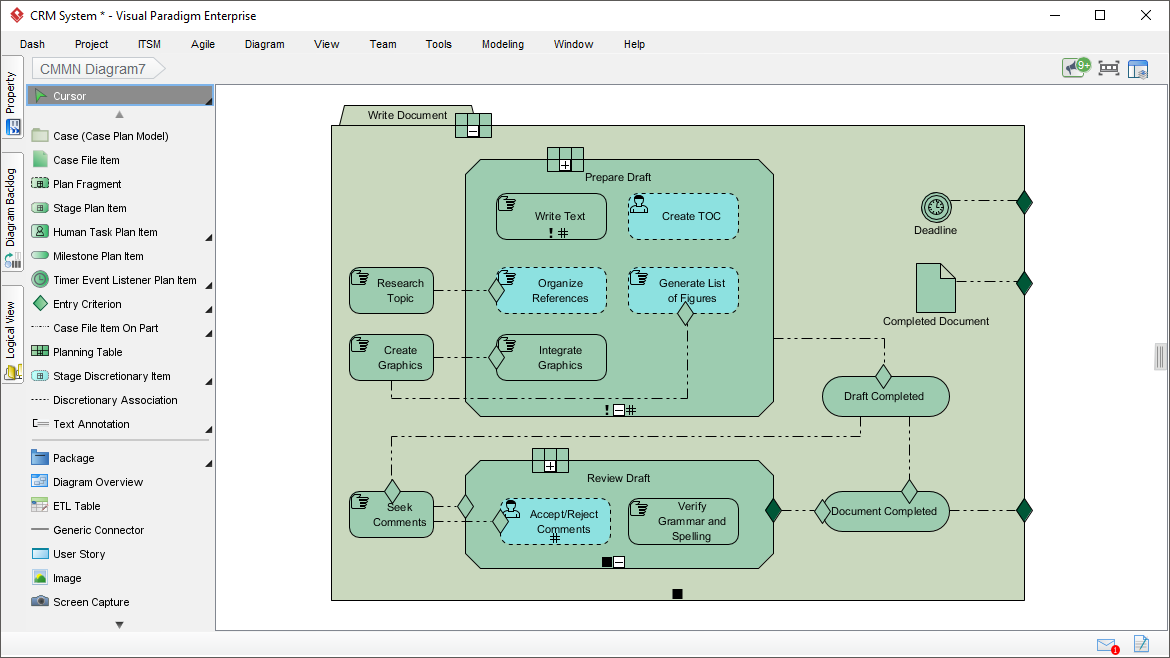Overview of CMMN and Its Benefits in Business Architecture
As a business architect, it is important to have a clear understanding of the process models and frameworks that support the design and management of business processes. One such framework is the Case Management Model and Notation (CMMN), which is a powerful and flexible approach for modeling and managing case-based business processes. In this article, we will provide an overview of CMMN and its benefits, and show how you can use Visual Paradigm to draw CMMN diagrams.
What is CMMN?
CMMN is a modeling language and framework for case management, which is a specialized form of business process management that deals with unpredictable, ad-hoc, and complex processes. CMMN provides a visual representation of case management processes, including the steps involved, the roles and responsibilities of participants, the decisions that need to be made, and the data that is processed. CMMN diagrams can be used to describe the flow of a case from start to finish, including the various stages, tasks, and events involved, as well as the relationships between different cases.
Advantages of CMMN
CMMN provides several advantages for business architecture, including:
- Flexibility: CMMN provides a flexible approach to modeling case management processes, which allows for the modeling of complex, ad-hoc, and unpredictable processes. This is particularly useful in situations where the process flow cannot be predicted or is subject to change, such as in legal, healthcare, or customer service applications.
- Modeling simplicity: CMMN is designed to be simple and intuitive, with a clear and concise syntax that makes it easy to understand and use. This simplifies the modeling process and makes it easier to understand the process flow and the relationships between different stages and tasks.
- Collaboration: CMMN supports collaboration among team members, stakeholders, and customers, which helps to ensure that the process model is accurate and reflects the needs of all involved parties.
- Reusability: CMMN diagrams can be reused and customized to fit specific needs, making it easier to adapt the process model to changing requirements.
- Interoperability: CMMN is an open standard, which means that it can be integrated with other process modeling frameworks, such as BPMN, and can be used in combination with other tools and systems.
Using Visual Paradigm for CMMN Diagrams

Visual Paradigm is a powerful and flexible tool for drawing CMMN diagrams and managing case management processes. To use Visual Paradigm for CMMN diagrams, follow these steps:
- Create a new project: Start by creating a new project in Visual Paradigm. You can do this by clicking on the “New Project” button in the Home tab or by selecting “File” > “New Project” from the main menu.
- Create a new CMMN diagram via the New Diagram window.
- Model your case management process: You can start modeling your case management process using the CMMN modeling language. You can use the CMMN modeling elements, such as stages, tasks, and events, to represent the steps involved in the case management process, and the relationships between different elements to represent the flow of the process.
Benefits of Using Visual Paradigm
- Collaborate with stakeholders: Visual Paradigm supports collaboration and version control, which allows you to work together with other stakeholders and keep track of changes over time. You can share your CMMN diagrams with team members and stakeholders, and receive feedback and suggestions for improvement.
- Analyze and refine the process: Visual Paradigm provides several analysis and simulation tools, such as simulation and traceability, which allow you to analyze and refine the process flow, identify potential bottlenecks, and make changes as needed.
- Generate reports: Visual Paradigm also supports the generation of reports, which can be used to document the case management process, provide a clear and concise overview of the process flow, and present the results of analysis and simulation.
Conclusion
CMMN is a powerful and flexible approach for modeling and managing case-based business processes, and Visual Paradigm provides a user-friendly and powerful tool for drawing CMMN diagrams and managing case management processes. By leveraging the benefits of CMMN and the capabilities of Visual Paradigm, business architects can improve the design, analysis, and management of their case management processes.
Related Links

